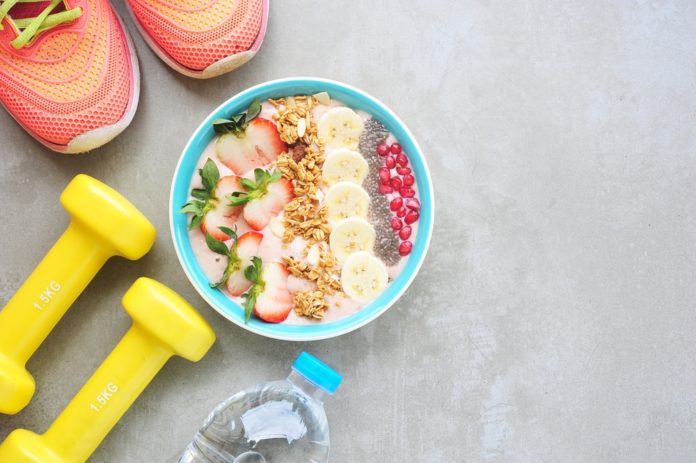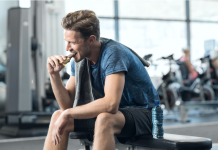It’s all too common… You hit the gym hard and make the trek back home, only to head to the kitchen and raven down your pantry. But what exactly causes that increased hunger levels post-workout and how can you curb and control your appetite after exercise?
Why Am I Hungry Post-Workout?
There are numerous factors that may cause you to work up an appetite after a workout, including both psychological and physiological responses. Think about it: You just worked out hard and your body needs to take in those extra calories it lost, right? Well, to an extent. But really you should not overcompensate on calories and view food as a reward from the tough workout you just successfully tackled. Doing so can essentially unwind all the efforts you put into the gym, especially if noshing on high-sugar and fat foods.
Physiologically, too, the body often starts to become hungry within thirty minutes to an hour post-workout and perhaps why you feel ravenous when you make it back home from the gym. This hunger pangs are mostly linked to drops in glucose and glycogen stores, which are likely to occur as the muscles and body uses it for energy. Additionally, low blood sugars may also cause ghrelin to surge, which is a hormone responsible for stimulating and controlling hunger.
How to Control Appetite After Exercise
Ultimately, though, hunger varies between individuals based on gender, the type of activity, and fitness levels, while caloric needs are also dependent on the identified factors. A Registered Dietitian can help determine individualized nutrient needs to accommodate health and fitness goals, though tips and tricks to control appetite after exercise can help steer you away from eating down the house!
1. Fuel Up with A Pre-Workout Snack
Fueling up on a pre-workout snack can keep blood sugars stable and prevent against those pesky post-exercise cravings. A pre-workout snack should be consumed at least 30 to 60 minutes before exercising and mostly consist of easy-to-digest carb and protein, including a banana with peanut butter, cottage cheese and berries, and an English muffin with cream cheese and salmon.
2. Reframe Your Mindset
Rather than viewing food as a reward and working out solely to guiltlessly enjoy a cupcake, view food as the body’s primary tool for recovery. Reframing your mindset can nurture a healthier relationship to food, along with prompting you to select more nutritious and beneficial foods for the body.
3. Workout Before a Meal
If you find yourself ravenous after working out no matter what, be strategic about the timing of meals and workouts. For instance, if you often workout after breakfast or dinner, try to workout before a main meal. But if it has been more than three hours since your last meal, don’t forget about that pre-workout snack.
4. Have Meals Prepared
As soon as you get home, you may be heading to the kitchen and grabbing for anything in sight. Not only does this break the opportunity to properly refuel the body, but poses the risk of overeating. So rather than consuming handfuls of cookies and chips before dinner is ready, have meals prepared and on deck for quick access. For instance, have the crockpot warming up a protein-packed chili or chicken burrito bowls already assembled. Ordering from Balance by bistroMD can also keep you stocked and ready when quick, nutritious meals are needed to defeat those uncontrollable post-workout hunger levels.
5. Sip On Water
Hydration is just as important as feeding the body with nutritious foods and often gets mistaken as hunger. And during a workout, you lose fluids as you sweat and rehydration is key to proper recovery. As a general reference, drink at least 64-ounces of water daily, 16 ounces of water leading up to activity, and six to 12 ounces immediately prior to exercise and every 15 to 20 minutes of active training.
6. Stay Consistent with Meal Timings
While we should be taking into consideration our personal hunger levels before eating, staying consistent with meal timings can help keep hunger levels at bay even amidst a workout. Common meal patterns include breakfast, lunch, and dinner, along with a couple nutritious snacks. Nonetheless, each meal plate should consist of a lean protein source and a bountiful of veggies and fruits, along with being complemented with a healthy fat and complex carb source. Snacks should also include satiating fiber and protein to lower the risk of overeating at the next main meal.
7. Sleep
Sleep is beneficial in a number of ways, including allowing the body it needs for proper recovery and lowering the risk of foods cravings towards high-fat and sugary foods. And not to mention, a good night’s rest also keeps you energized to tackle more workouts on a regular basis! Ultimately, adults should aim for seven to nine hours of sleep on a nightly basis.









